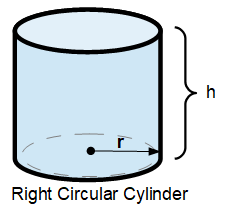The Metal Cylinder Weight calculator computes the weight (mass) of a cylinder based on the radius of the cylinder, the height of the cylinder, and the density of the metal. The default is set to the density of steel (7,850 kg/m3). 
INSTRUCTIONS: Choose units and enter the following.
- (h) Height
- (r) Radius of Base
- (mD) Mean Density of Metal (Default of 7850 kg/m3 is for steel)
Metal Cylinder Weight (Wt): The weight (mass) is returned in grams, grains and ounces, with the volume of the cylinder in cubic centimeters. However, these can be automatically converted to compatible units via the pull-down menu.
The Math / Science
The weight or mass of a right circular cylinder formula computes the mass of a right cylinder as a function of the mean density (mD) of the composition and the volume calculated using the radius (r) of the base and the height (h). The default results will be in kilograms but can be converted to any of the system provided units. The formula for the weight of a cylinder is:
Wt=[π⋅r2⋅h]⋅mD
where:
- Wt = weight of the cylinder
- r = radius of cylinder
- h = height of cylinder
- mD = mean density of steel.
The formula to compute the volume of the geometric shape based on the input parameters. Using the volume of a cylinder, the formula for mass from volume and density:
where:
- V is the volume
- mD is the mean density.
|
Metals Densities
|
Metals are materials characterized by its physical and chemical properties, primarily its ability to conduct electricity and heat, its luster or shine when polished, its malleability (ability to be hammered or pressed into shapes), and its ductility (ability to be drawn into wires). Metals typically have a crystalline structure and are found naturally in solid form (with the exception of mercury, which is a liquid at room temperature).
Metals make up a large portion of the periodic table of elements, with examples including iron, copper, gold, silver, aluminum, and titanium, among many others. Metals are essential in various industries such as construction, manufacturing, electronics, transportation, and energy production due to their unique properties and versatility.
Metals are generally dense materials. Density is a measure of how much mass is contained in a given volume. Metals tend to have high densities because their atoms are closely packed together in a crystalline structure. This close packing of atoms contributes to their characteristic properties such as strength, malleability, and conductivity.
However, it's important to note that the density of metals can vary widely depending on factors such as their elemental composition, crystal structure, and any impurities present. For example, some metals like lead and platinum are denser than others like aluminum or magnesium.
Cylinder Calculators
- Cylinder Side Area: Computes the surface area of the sides of a cylinder based on height and radius.
- Cylinder Surface Area: Computes the total surface area of a cylinder including sides, top and bottom.
- Cylinder Volume: Computes the volume of a cylinder based on cylinder height and radius.
- Cylinder Volume from Height and Circumference: Computes the volume of a cylinder based on the height and circumference. It also returns the diameter of the cylinder.
- Cylinder Height: Computes the height of a cylinder based on the volume and radius.
- Cylinder Radius: Computes the radius and diameter of a cylinder based on the volume and height.
- Cylinder Weight: Computes the weight, mass and volume of a cylinder based on the height, radius and density.
- Cylinder Mass Computes the mass of a cylinder based on the radius and height and mean density of the cylinder.
- Volume in Horizontal Cylinder: Computes partial volume of a horizontal circular cylinder based on the radius and length of the cylinder and the vertical height of the contents in the cylinder (see diagram).
- Cylinder Density: Computes the mean density of a cylinder based on the mass and computed volume from the radius and height.
- Slanted Cylinder Surface Area: Computes the surface area of a slanted cylinder based on the radius and side length (L).
- Slanted Cylinder Area from Angle: Computes the lateral area (surface area of the sides) of a slanted cylinder based on its radius, height and slant angle (θ).
- Slanted Cylinder Volume: Computes the volume of a slanted cylinder based on the radius of the base, side length and slant angle.
- Slanted Cylinder Weight: Computes the weight or mass of a slanted cylinder based on the radius, side length, slant angle and density.
- Cylinder MoI about Central Axis: Computes the moment of inertia of a cylinder about its central axis based on the mass and radius.
- Cylinder MoI about the End: Computes the moment of inertia of a solid circular cylinder of uniform density about an axis along the diameter of the cylinder at one end.
- Cylinder MoI Perpendicular to Axis: Computes the moment of inertia of a solid circular cylinder of uniform density about an axis perpendicular to the axis of the cylinder and through the center of mass.
